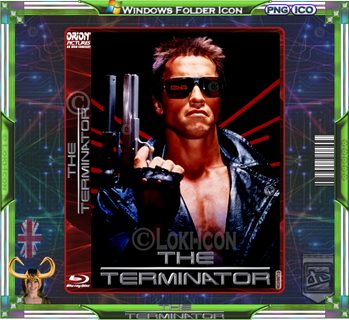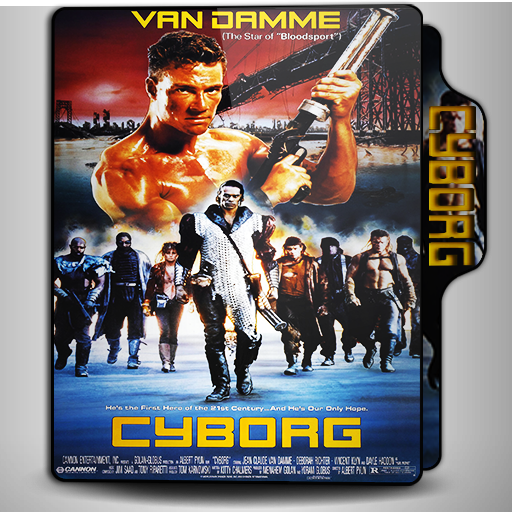HOME | DD
 Jacob-the-Fox-Critic — The Terminator (1984) Review
Jacob-the-Fox-Critic — The Terminator (1984) Review

Published: 2020-11-04 21:12:37 +0000 UTC; Views: 4800; Favourites: 28; Downloads: 2
Redirect to original
Description
Lets begin another franchise with James Cameron's breakthrough film featuring two time travelers. One sent to kill a young woman, and the other sent to protect her.In 1984 Los Angeles, a cyborg assassin known as a Terminator arrives from 2029 and steals guns and clothes. Kyle Reese, a human soldier sent back in time from the same year, arrives shortly afterwards. The Terminator begins systematically killing women named Sarah Connor, whose addresses it finds in the telephone directory. It tracks the last Sarah Connor to a nightclub, but Kyle rescues her. They steal a car and escape with the Terminator pursuing in a police car. Kyle explains to Sarah that an artificial intelligence defense network, Skynet, created by Cyberdyne Systems, will become self-aware in the near future and initiate a nuclear holocaust. Sarah's future son John will rally the survivors and lead a resistance movement against Skynet and its army of machines. With the Resistance on the verge of victory, Skynet sent a Terminator back in time to kill Sarah before John is born to prevent the formation of the Resistance. The Terminator, a Cyberdyne Systems Model 101, is an efficient killing machine with a powerful metal endoskeleton and an external layer of living tissue that makes it appear human. Now Sarah must ensure her survival with the help of Kyle, and find a way to destroy the Terminator.
Pros:
1. The Terminator (T-800) is an awesome villain.
2. Sarah and Kyle are both great protagonists.
3. Memorable minor characters like Ginger, Silberman, Traxler, and Vulkovich.
4. The makeup and animatronics are pretty well crafted.
5. Pretty awesome action scenes.
6. Brad Fiedel delivers a very well done and memorable score.
7. There's an awesome blend of action, science fiction, and drama.
8. Great performances from the cast.
9. The overall design of the Terminator is very well crafted.
10. There are some well handled comedic moments.
11. The plot is very well written, and provides great character and story development.
12. Tons of memorable moments and lines.
13. Most of the special effects are very well done.
Cons:
1. Some of the effects haven't aged well.
2. There are a couple of slow moments.
Overall:
This is a spectacular movie, and is a must watch for any sci-Fi or action fan.
Rating:
9.5/10 (Amazing to Perfect)
Production Notes and Trivia:
1. In Rome, Italy, during the release of Piranha II: The Spawning, director Cameron fell ill and had a dream about a metallic torso holding kitchen knives dragging itself from an explosion. Inspired by director John Carpenter, who had made the slasher film Halloween on a low budget, Cameron used the dream as a "launching pad" to write a slasher-style film. Cameron's agent disliked the early concept of the horror film and requested that he work on something else. After this, Cameron dismissed his agent.
2. Cameron returned to Pomona, California and stayed at the home of science fiction writer Randall Frakes, where he wrote the draft for The Terminator. Cameron's influences included 1950s science fiction films, the 1960s fantasy television series The Outer Limits, and contemporary films such as The Driver and Mad Max 2. To translate the draft into a script, Cameron enlisted his friend Bill Wisher, who had a similar approach to storytelling. Cameron gave Wisher scenes involving Sarah Connor and the police department to write. As Wisher lived far from Cameron, the two communicated ideas by recording tapes of what they wrote by telephone. Frakes and Wisher would later write the US-released novelization of the movie.
3. The initial outline of the script involved two Terminators being sent to the past. The first was similar to the Terminator in the film, while the second was made of liquid metal and could not be destroyed with conventional weaponry. Cameron felt that the technology of the time was unable to create the liquid Terminator, and returned to the idea with the T-1000 character in Terminator 2.
4. Gale Anne Hurd, who had worked at New World Pictures as Roger Corman's assistant, showed interest in the project. Cameron sold the rights for The Terminator to Hurd for one dollar with the promise that she would produce it only if Cameron was to direct it. Hurd suggested edits to the script and took a screenwriting credit in the film, though Cameron stated that she "did no actual writing at all". Cameron and Hurd had friends who worked with Corman previously and who were working at Orion Pictures (now part of MGM). Orion agreed to distribute the film if Cameron could get financial backing elsewhere. The script was picked up by John Daly, chairman and president of Hemdale Film Corporation. Daly and his executive vice president and head of production Derek Gibson became executive producers of the project.
5. Cameron wanted his pitch for Daly to finalize the deal and had his friend Lance Henriksen show up to the meeting early dressed and acting like the Terminator. Henriksen, wearing a leather jacket, fake cuts on his face, and gold foil on his teeth, kicked open the door to the office and then sat in a chair. Cameron arrived shortly and then relieved the staff from Henriksen's act. Daly was impressed by the screenplay and Cameron's sketches and passion for the film. In late 1982, Daly agreed to back the film with help from HBO and Orion.
6. For the role of Kyle Reese, Orion wanted a star whose popularity was rising in the United States but who also would have foreign appeal. Orion co-founder Mike Medavoy had met Arnold Schwarzenegger and sent his agent the script for The Terminator. Cameron was uncertain about casting Schwarzenegger as Reese as he felt he would need someone even more famous to play the Terminator. Sylvester Stallone and Mel Gibson both turned down the Terminator role. The studio suggested O. J. Simpson but Cameron, ironically, did not feel that Simpson would be believable as a killer. Cameron agreed to meet with Schwarzenegger and devised a plan to avoid casting him; he would pick a fight with him and return to Hemdale and find him unfit for the role. However, Cameron was entertained by Schwarzenegger, who would talk about how the villain should be played. Cameron began sketching his face on a notepad and asked Schwarzenegger to stop talking and remain still. After the meeting, Cameron returned to Daly saying Schwarzenegger would not play Reese but that "he'd make a hell of a Terminator". Sting was later considered for Reese before Cameron chose Michael Biehn.
7. Filming for The Terminator was set to begin in early 1983 in Toronto, but was halted when producer Dino De Laurentiis applied an option in Schwarzenegger's contract that would make him unavailable for nine months while he was filming Conan the Destroyer. During the waiting period, Cameron was contracted to write the script for Rambo: First Blood Part II, refined the Terminator script, and met with producers David Giler and Walter Hill to discuss a sequel to Alien, which became Aliens, released in 1986.
8. There was limited interference from Orion Pictures. Two suggestions Orion put forward included the addition of a canine android for Reese, which Cameron refused, and to strengthen the love interest between Sarah and Reese, which Cameron accepted. To create the Terminator's look, Winston and Cameron passed sketches back and forth, eventually deciding on a design nearly identical to Cameron's original drawing in Rome. Winston had a team of seven artists work for six months to create a Terminator puppet; it was first molded in clay, then plaster reinforced with steel ribbing. These pieces were then sanded, painted and then chrome-plated. Winston sculpted reproduction of Schwarzenegger's face in several poses out of silicone, clay and plaster.
9. The sequences set in 2029 and the stop-motion scenes were developed by Fantasy II, a special effects company headed by Gene Warren Junior. A stop-motion model is used in several scenes in the film involving the Terminator's skeletal frame. Cameron wanted to convince the audience that the model of the structure was capable of doing what they saw Schwarzenegger doing. To allow this, a scene was filmed of Schwarzenegger injured and limping away; this limp made it easier for the model to imitate Schwarzenegger.
10. One of the guns seen in the film and on the film's poster was an AMT Longslide pistol modified by Ed Reynolds from SureFire to include a laser sight. Both non-functioning and functioning versions of the prop were created. At the time the movie was made, diode lasers were not available; because of the high power requirement, the helium–neon laser in the sight used an external power supply that Schwarzenegger had to activate manually. Reynolds states that his only compensation for the project was promotional material for the film.
11. In March 1984, the film began production in Los Angeles. Cameron felt that with Schwarzenegger on the set, the style of the film changed, explaining that "the movie took on a larger-than-life sheen. I just found myself on the set doing things I didn't think I would do – scenes that were just purely horrific that just couldn't be, because now they were too flamboyant." Most of The Terminator's action scenes were filmed at night, which led to tight filming schedules before sunrise. A week before filming started, Linda Hamilton sprained her ankle, leading to a production change whereby the scenes in which Hamilton needed to run occurred as late as the filming schedule allowed. Hamilton's ankle was taped every day and she spent most of the film production in pain.
12. Schwarzenegger tried to have the iconic line "I'll be back" changed as he had difficulty pronouncing the word I'll. He also felt that his robotic character would not speak in contractions and that the Terminator would be more declarative. Cameron refused to change the line to "I will be back", so Schwarzenegger worked to say the line as written the best he could. He would later say the line in numerous films throughout his career.
13. After production finished on The Terminator, some post-production shots were needed. These included scenes showing the Terminator outside Sarah Connor's apartment, Reese being zipped into a body bag, and the Terminator's head being crushed in a press. The final scene where Sarah is driving down a highway was filmed without a permit. Cameron and Hurd convinced an officer who confronted them that they were making a UCLA student film.
Related content
Comments: 3

👍: 0 ⏩: 0

👍: 0 ⏩: 0

👍: 0 ⏩: 0























